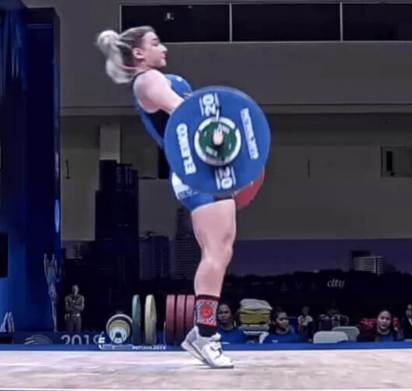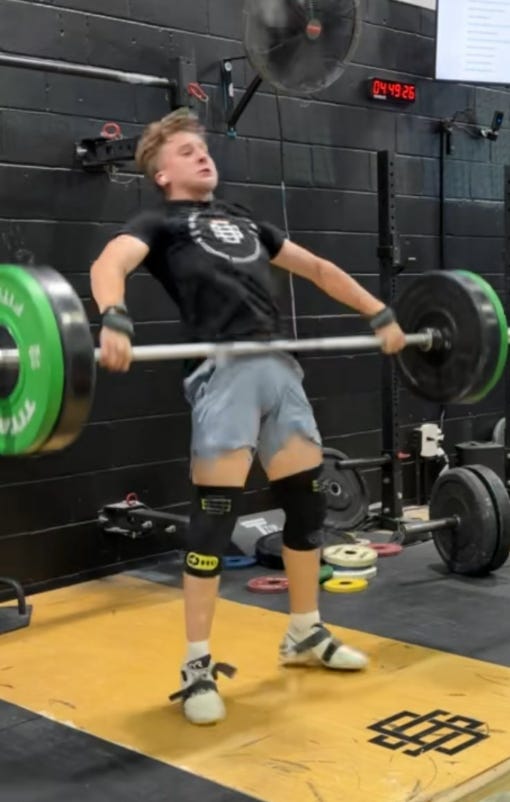What Is Triple Extension?
What exactly is triple extension? Does triple extension transfer to jumping and sprinting? Do athletes need to focus on it during their lifts, or does it happen naturally? Do athletes need to train in Olympic lifting specifically?
This article will answer these questions.
Triple Extension Explained
Triple extension is the extension of the ankles, knees, and hips. We see a lifter below doing just that during a snatch. It also occurs during the clean and jerk, and during power cleans or snatches.

Extension is when the angle between two parts of your body increases. Think of it this way: when you stand tall and put your arms over your head, you’re extending. When you curl up into a ball, you’re flexing.
Olympic lifting coaches love to point out that triple extension also occurs during jumping and sprinting motions. They’re not wrong. Take a look at these photos, one of a box jump and another during sprinting. There is a similar extension of the ankles, knees, and hips.
As we can see, it’s quite clear that triple extension is important during a variety of athletic movements. Some studies suggest that ankle and knee extension are more important than hip extension, but the fact remains that all three are connected in such a way that they should all be extended simultaneously, regardless.
So then, does the triple extension achieved during Olympic lifting transfer to jumping and sprinting? Put differently, does Olympic lifting make you a better athlete?
Does Olympic Lifting Transfer To Athletics?
At first glance, the answer to this question seems to be an obvious yes. When coaches train their athletes in the Olympic lifts, they often tell them to “jump” or to get “on their toes” at the finish. Though keep in mind, you don’t want your athletes’ feet to leave the ground that significantly, if at all. If they’re jumping two inches into the air every time they clean, they’re losing a ton of power. It should be less than an inch.
This “jump” or the athlete “getting on their toes” is what creates triple extension during their lift. So, when cueing your athlete to jump, you’re telling them to triple extend. You don’t have to tell them to “triple extend.” If you did that, then you’d have to explain triple extension, and maybe even have them read this article! We want to keep it simple for those athletes; just telling them to jump during their lifts works great.

Since Olympic lifts mimic the jumping motion, they should transfer over to jumping ability, right? Many exercise scientists have studied this question, and the answer seems to be yes, according to the National Association of Sports Medicine.
Daniel Hackett and others found that Olympic Weightlifting increased vertical jump height at the same rate as “plyometric” or jump training did in a review of six separate studies.1 One study by Anis Chaouachi and others showed that adding Olympic Weightlifting to a training program substantially increased the jumping and sprinting ability of young athletes.2 It did so at much better rates than the standard resistance training programs that others were given.
At The Moffitt Method, we are personally very familiar with these gains in explosiveness in athletes through Olympic Lifting. It is one of the core aspects of our training program, and we have produced many extremely explosive athletes at the high school and college level for decades.
All that being said, if we don’t want to coach triple extension directly, but we also don’t want to use the Olympic Lifts, what else can we do?
How To Train Triple Extension Without Olympic Lifts
The answer here is simple: do jumps and sprints.
A jump is by definition something that involves triple extension. Whether it’s a broad jump, box jump, or sprint, it’s all triple extension.
That being said, why train Olympic lifting if you can get better at jumping by doing jumps? This is a great question. Olympic lifting serves as an intermediate between traditional strength exercises like squats and explosiveness training like jumps.
One of the key principles behind strength training is the yearly cycle. During that cycle, we start with higher rep exercises to condition and slowly move from that high rep the lower rep exercises that get them explosive and ready for the field. Olympic lifts help bridge athletes, or in other words, conditioning and slower strength movements to more explosive movements like sprinting and jumping.
Another reason to train Olympic lifts is that they train triple extension while under an external load. Many athletes, especially football and basketball players, have to produce a lot of force while under the pressure of an external load, or in other words, another person. Unweighted jumps do not do this.
What are some common mistakes made when training triple extension?
Here are some of the more common mistakes made when training triple extension.
- Doing high volume.When training for explosiveness, it’s important to remember the SAID principle, which stands for specific adaptation to imposed demand. That means your body gets good at what it trains for. So, if you want to get explosive and jump higher, train jumps with low reps, focusing on jumping as high as possible.
- Training highly specific jumps.The SAID principle also applies here. When training our athletes, we want to focus on jumps that they actually do during their sport. Football athletes often sprint forward, so we want to train that. Sometimes they move laterally, so we should train that. We shouldn’t train some strange new movement that isn’t actually done on the field.
- Training only one side of the Force-Velocity curve.We addressed this earlier indirectly, when discussing how Olympic lifts transfer us from strength training to speed training. The force velocity curve is simply a spectrum between strength and speed. Olympic lifts focus more on forceful use of triple extension, and jumps focus more on speedy triple extension. Having both in your program covers both sides of the force-velocity spectrum.
Training athletes often involves movements that train triple extension, but training specifically triple extension is not necessary, and focusing on it will confuse your athletes. You can train triple extension through Olympic lifts, which will make your athletes much better at jumping and sprinting. If you can’t do Olympic lifts, you can always get better at jumping by simply adding jumps to your workout.
If you’re looking for a program that incorporates principles like these, sign up for The Moffitt Method today. We make online strength and conditioning programs for high schools and colleges that get athletes stronger, healthier, and help you win more championships.
Written by Matt Bruce, 2 two-time Olympic alternate and strength coach for over a decade.

